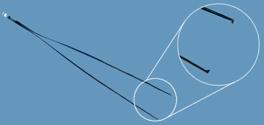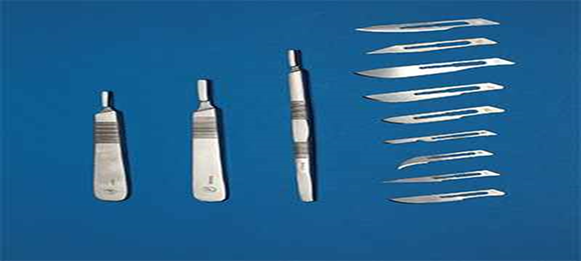
Part Three
- Illustrated Atlas
Surgical instruments
Scissors
Classification by type:
All types of scissors have either sharp or blunt edges. (A: sharp, sharp, B: sharp, sharp). All types have either straight or curved blades.
Figure (1)

Mayo and Metzenbaum

Mayo shears (B) are used to cut thick flaps and sutures. Metzenbaum (A) shears are thinner than Mayo shears.
Scissors are used to cut thin tissue.
Dressing and Tissue Forceps
Tweezers consist of two teeth held together at the end and equipped with a spring to make the teeth open from each other.
The forceps can be used for weaving or bandaging.
Dressing forceps have fine teeth.
Tissue forceps have teeth to grasp tissue.
Most tweezers bear the name of the designer's origin, such as Edison tweezers.
Rat Tooth forceps:
Its teeth hold tissue without slipping. It is used to hold skin and dense tissue
Figure (2)

Adson Tissue Forceps:
Small serrated teeth on the edge of the tip. Edison tissue forceps have fine, serrated tips designed to carefully grip tissue.
Figure (3)

Intestinal Tissue Forceps:
Forceps close when used to collect Allis tissue grabs
Intestinal tissue forceps: used to grasp the intestine, tissues, omentum, and skin.
Figure (4)

Babcoca intestinal tissue forceps:
Figure (5)

Its serrated teeth are smoother than Allis forceps. It has a broad, outward-flaring end with a smooth tip and is used to grasp traumatic viscera (intestines and bladder).
Spong Forceps sponge mask:
Figure (6)

Sponge grippers can be straight or curved, and their ends are either serrated or smooth. They are used to grip traumatic viscera (intestines, bladder).
Hemostats
Hemostatic forceps:
Tweezers close when in use. Most bleeding clippers carry the designer's name (Kelly, Holstead, Crila) and are used to hold and tighten blood vessels.
They are classified according to their sizes, shapes, and top sizes:
Bleed cutters can be either curved or straight.
Figure (7)

Kelly hemostatic forceps and mosquito hemostats:
Kelly bleeding interrupter (b).
The mosquito cutter (a) is thinner than (b).
Both are transversely serrated.
Figure (8)

Comparison between Kelly and Mosquito bleed cutter ends:
A: It has a small ending
Bleeding cutter carmalt:
It is preferable to use it to hold the ovarian vessels during oophorectomy because its serrations are longitudinal.
Figure (9)

Intestinal Forceps
Doyen Intestinal Forceps:
It has longitudinal teeth, which are used to hold the intestine and temporarily block its lumen.
Figure (10)

Payr Pylorus Clamps tool
An intestinal crushing device used to close the end of the intestine when it is removed.
Figure (11)

Needle Holders
A tool that closes during use and is used to hold the surgical needle while suturing tissue. There are good types that have tungsten carbide added to the tip.
Figure (12)

Mayo-Hegar mask:
Heavy with moderate articulation and no cutting edge.
Olsen Mask Olsen – Hegar:
Figure (13)

It involves the work of both a holder and scissors, but equally as having a sharp edge, it can accidentally cut sewing tools.
Hand Held Retractors
Senn tool:
Figure (14)

It has edges at its ends, and the edges can be blunt (fine or more sharp).
Used for peritoneum.
Hohman tool:
Figure (15)

It is used to lift tissue away from the bone during splinting.
Self Retaining Retaraceors
Weitlaner wound retractor:
Its edges can be sharp or blunt, and it has a tool like a hay picker and a holder to keep the fabrics apart.
Figure (16)

Gelpi wound remover:
Figure (17)

It has a single tapered tip and has a holder to hold the weaves apart.
Blades Scalpels and
handles:
3 gauge handle and 4 gauge handle
Figure (18)

Handles and blades:
The blades (size 10, 11, 12, 15) fit the handle size 3, and the blades (size 22, 23) fit the handle size 4. They are often used on large animals.
Figure (19)

Disposable Scalpel:
Figure (20)

Towel Clamps
The towel holder is used to hold a clean towel on the skin of the sick animal and can be used to hold tissues.
Backhaus towel clamp
Figure (21)

Curved holder closes during use
(2) scalpels:
The scalpel is held by the thumb, middle finger, and ring finger, while the index finger is on the upper edge to direct the scalpel and make a smooth, long, continuous cut that causes less tissue trauma compared to a long, discontinuous cutting motion.
Figure (22)

The scalpel should not be used for stabbing movements.
Figure (23)

Devices inside operations:-










Blood pressure chart
Reviewer
· World Health Organization (2012): Legal procedures governing human organ transplantation in Egypt, available on the website www.emro.who.int/press-releases.html
· First aid guide
· Egyptian Ministry of Foreign Affairs (2010): Equipment and requirements that must be available in organ transplant operating rooms, available on the website www.mfa.gov.eg/Arabic/Ministry/TraffickinginPersons/
· (The American Hope Project in cooperation with the Egyptian Red Crescent)
· Nursing Procedures Quality Handbook
· Your guide to the basics and skills of nursing (Egyptian-Korean side)
1-summary: 2015 American Heart Association Guidelines Update
for Cardiopulmonary Resuscitation and Emergency Cardiovascular
Care. Circulation. 2015;132(18)(suppl 2). In press.
2. Hazinski MF, Nolan JP, Aicken R, et al. Part 1: executive summary:
2015 International Consensus on Cardiopulmonary Resuscitation
and Emergency Cardiovascular Care Science With Treatment
Recommendations. Circulation. 2015;132(16)(suppl 1). In press.
